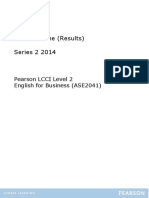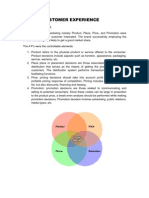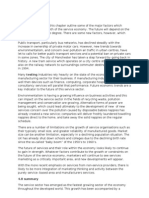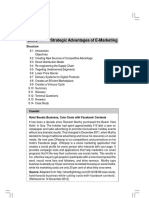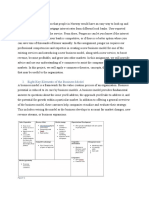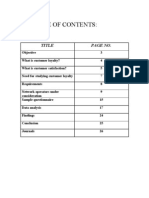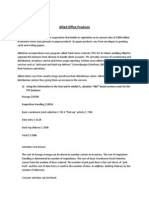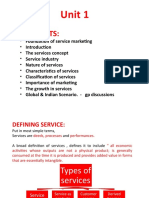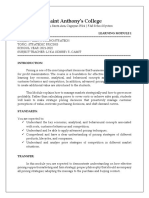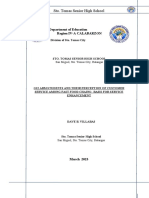0 ratings0% found this document useful (0 votes)
58 viewsMini Case Differentiating Customer Service According To Customer Value at Akzo Nobel NI
Mini Case Differentiating Customer Service According To Customer Value at Akzo Nobel NI
Uploaded by
Soumya Prakash NayakAkzo Nobel, a large chemical and paint manufacturer, established a tiered customer service policy for its polymer division in the early 2000s. They recognized customers were demanding more services like product disposal and flexible delivery options without paying more. An investigation found little correlation between service levels and customer profitability. This led Akzo Nobel to develop a formal framework linking services to contribution margins calculated in a new customer scorecard. Services were designated as free, negotiable, or unavailable based on customer type and value to improve understanding of profit drivers and bottom line results.
Copyright:
© All Rights Reserved
Available Formats
Download as DOCX, PDF, TXT or read online from Scribd
Mini Case Differentiating Customer Service According To Customer Value at Akzo Nobel NI
Mini Case Differentiating Customer Service According To Customer Value at Akzo Nobel NI
Uploaded by
Soumya Prakash Nayak0 ratings0% found this document useful (0 votes)
58 views1 pageAkzo Nobel, a large chemical and paint manufacturer, established a tiered customer service policy for its polymer division in the early 2000s. They recognized customers were demanding more services like product disposal and flexible delivery options without paying more. An investigation found little correlation between service levels and customer profitability. This led Akzo Nobel to develop a formal framework linking services to contribution margins calculated in a new customer scorecard. Services were designated as free, negotiable, or unavailable based on customer type and value to improve understanding of profit drivers and bottom line results.
Original Title
Mini Case_Akzo Nobel
Copyright
© © All Rights Reserved
Available Formats
DOCX, PDF, TXT or read online from Scribd
Share this document
Did you find this document useful?
Is this content inappropriate?
Akzo Nobel, a large chemical and paint manufacturer, established a tiered customer service policy for its polymer division in the early 2000s. They recognized customers were demanding more services like product disposal and flexible delivery options without paying more. An investigation found little correlation between service levels and customer profitability. This led Akzo Nobel to develop a formal framework linking services to contribution margins calculated in a new customer scorecard. Services were designated as free, negotiable, or unavailable based on customer type and value to improve understanding of profit drivers and bottom line results.
Copyright:
© All Rights Reserved
Available Formats
Download as DOCX, PDF, TXT or read online from Scribd
Download as docx, pdf, or txt
0 ratings0% found this document useful (0 votes)
58 views1 pageMini Case Differentiating Customer Service According To Customer Value at Akzo Nobel NI
Mini Case Differentiating Customer Service According To Customer Value at Akzo Nobel NI
Uploaded by
Soumya Prakash NayakAkzo Nobel, a large chemical and paint manufacturer, established a tiered customer service policy for its polymer division in the early 2000s. They recognized customers were demanding more services like product disposal and flexible delivery options without paying more. An investigation found little correlation between service levels and customer profitability. This led Akzo Nobel to develop a formal framework linking services to contribution margins calculated in a new customer scorecard. Services were designated as free, negotiable, or unavailable based on customer type and value to improve understanding of profit drivers and bottom line results.
Copyright:
© All Rights Reserved
Available Formats
Download as DOCX, PDF, TXT or read online from Scribd
Download as docx, pdf, or txt
You are on page 1of 1
Mini Case
Differentiating Customer Service According to Customer Value at Akzo Nobel NI
Akzo Nobel, headquartered in Arnhem, Nertherlands, is one of worlds largest chemical
manufacturers and also one of the world’s largest paint makers. Its chemical unit produces pulp
and paper chemicals, functional chemicals (including flame retardants and animal feed
additives), surfactants (used in detergents and personal care products), polymers, and catalysts.
The polymer division, which serves exclusively the B-to-B market, established a tiered
customer-service policy in the early 2000s. The necessity to introduce this policy came out of
the recognition that customers are becoming more and more demanding when it comes to
asking for additional services around the purchase of polymer products. For example,
customers became increasingly aware that Akzo Nobel offers product disposal services, delivers
nonstandard pallet sizes, and offers negotiable delivery times. On the one hand, Akzo Nobel did
not typically charge for these services, and on the other hand, while extended services were
typically offered only to medium- to high-volume clients, the relationship between service
offerings and client profitability was not clear. When Akzo Nobel investigated more closely who
received the service offerings, it found the correlation with client profitability (i.e., contribution
margin) was very low. This finding led to the development of a formal tiered service-level
framework within the polymer division.
In the first step, the company developed a thorough list of all possible service activities
the company currently offers. Interestingly, the sales force provided a significant number of
these services with little further consideration. Since the sales force was compensated on the
sales volume it generated, it had all the incentive to lure in clients with little consideration for
bottom-line results. Concurrently, to formalize customer service activities, the company
implemented a customer scorecard mechanism. The scorecard allowed it to measure and
document contribution margins per individual customer. Based on these two pieces of
information, the organization then specified which customer type should be eligible for which
type of service. In terms of service allocation, it designated certain services would be free for all
types of customers, certain services would be subject to negotiation for lower-level customers,
and finally, certain services would not be available for the least valuable set of customers.
Although the sales force was not very happy at first with these new measures, the new policy
had a dramatic impact on the sales force understanding of the drivers of customer profitability.
Questions
1. How can an organization compute client-level profitability?
2. What types of systems and processes are needed to document client profitability in a
systematic and ongoing fashion?
3. Is there a way to move established clients accustomed to receiving a large number of
ancillary services for free to paying for these services?
You might also like
- INSTRUCTION: Examine The Sample Questionnaire Below. Then, Answer The Follow-Up QuestionsDocument2 pagesINSTRUCTION: Examine The Sample Questionnaire Below. Then, Answer The Follow-Up QuestionsSTEVE JHONSON Lepasana0% (1)
- UNIT 4 Service Delivery and PromotionDocument14 pagesUNIT 4 Service Delivery and PromotionBala Subramani100% (4)
- Marketing Concept - 5 Concepts of Marketing Explained With ExamplesDocument5 pagesMarketing Concept - 5 Concepts of Marketing Explained With ExamplesGirish Jadhav71% (7)
- English For Business L2 Model Answers Series 2 2014Document11 pagesEnglish For Business L2 Model Answers Series 2 2014zsu82No ratings yet
- HBR Article - How To Sell Services More ProfitablyDocument7 pagesHBR Article - How To Sell Services More ProfitablyNikhil GulviNo ratings yet
- Akzo Nobel Mini Case: Customer Relationship ManagementDocument5 pagesAkzo Nobel Mini Case: Customer Relationship ManagementSoumya Prakash NayakNo ratings yet
- TVL HK SHS Q3 M2Document8 pagesTVL HK SHS Q3 M2Mich AngustiaNo ratings yet
- Questions-Part: 1: Operation Management Course Homework #6 Amin Akrami Student ID: 99162538Document2 pagesQuestions-Part: 1: Operation Management Course Homework #6 Amin Akrami Student ID: 99162538Amin AkramiNo ratings yet
- Airtel FullDocument53 pagesAirtel FullAnnu GuptaNo ratings yet
- Puteri Customer ManagementDocument3 pagesPuteri Customer ManagementTira PuteriNo ratings yet
- Chapter+13+Summary MKT MGTDocument12 pagesChapter+13+Summary MKT MGTFerdous MostofaNo ratings yet
- B2B Bandits - Group 10Document6 pagesB2B Bandits - Group 10ANSHUMAN DASNo ratings yet
- B2B Bandits - Group 10 PDFDocument10 pagesB2B Bandits - Group 10 PDFANSHUMAN DASNo ratings yet
- Service Industry Value Chain AnalysisDocument4 pagesService Industry Value Chain AnalysisShubham JhaNo ratings yet
- Edited Mahgul (101 Bba 2k18)Document5 pagesEdited Mahgul (101 Bba 2k18)mahgul khanNo ratings yet
- Intellibuzz: People: Intellibuzz Was Started Sagar Mehta Who Then Had Done Bachelor in ComputerDocument5 pagesIntellibuzz: People: Intellibuzz Was Started Sagar Mehta Who Then Had Done Bachelor in ComputerKapil ShahNo ratings yet
- 4.2.1 Market Needs: Rebnick Eco-Green Lundary & Cleaning Services (RELCS)Document4 pages4.2.1 Market Needs: Rebnick Eco-Green Lundary & Cleaning Services (RELCS)douglasvictoreke67No ratings yet
- Services Marketing-Unit-Ii-ModifiedDocument48 pagesServices Marketing-Unit-Ii-Modifiedshiva12mayNo ratings yet
- Lesson 8 Importance of Services in Customer Satisfaction The Objective of This Lesson Is To Have An Insight IntoDocument6 pagesLesson 8 Importance of Services in Customer Satisfaction The Objective of This Lesson Is To Have An Insight IntoChetanya DhawanNo ratings yet
- Chapter 1 - Introduction To Services: Service Marketing Week 1Document14 pagesChapter 1 - Introduction To Services: Service Marketing Week 1Rhyn RutherfordNo ratings yet
- TVL HK SHS Q3 M2Document8 pagesTVL HK SHS Q3 M2Anton RimbsNo ratings yet
- Name Netid Group Number: Website Link: Tutorial Details Time Spent On AssignmentDocument9 pagesName Netid Group Number: Website Link: Tutorial Details Time Spent On Assignmentadur846No ratings yet
- Allen Manalo Casestudy1Document4 pagesAllen Manalo Casestudy1Allen ManaloNo ratings yet
- As Bulan IniDocument20 pagesAs Bulan IniMukti UtamaNo ratings yet
- Chapter 6-Group 6 ElectiveDocument8 pagesChapter 6-Group 6 ElectiveLevNo ratings yet
- Assignment No 1 Subject: Services Marketing Topic: Case StudyDocument14 pagesAssignment No 1 Subject: Services Marketing Topic: Case StudySaman KhanNo ratings yet
- Untitled DocumentDocument16 pagesUntitled DocumentUjjawal MishraNo ratings yet
- Notes Unit 4 KMB N MK 04Document19 pagesNotes Unit 4 KMB N MK 04Mohammad ShahvanNo ratings yet
- Service Chaper 1Document18 pagesService Chaper 1Hana TadeseNo ratings yet
- Allen Manalo Casestudy1Document4 pagesAllen Manalo Casestudy1Allen ManaloNo ratings yet
- Tuck Casebook 2000 For Case Interview Practice - MasterTheCaseDocument71 pagesTuck Casebook 2000 For Case Interview Practice - MasterTheCaseMasterTheCase.comNo ratings yet
- Service Logic PaperDocument8 pagesService Logic PaperquadranteRDNo ratings yet
- Customer ExperienceDocument8 pagesCustomer Experienceshaswat148No ratings yet
- 11Document6 pages11Jasmeet Kaur100% (3)
- Services Marketing: Prepared by Dr. Sahar NagatyDocument16 pagesServices Marketing: Prepared by Dr. Sahar NagatyPradeep BiradarNo ratings yet
- DocxDocument11 pagesDocxEnnaira ArumeraNo ratings yet
- Marketing Is The Flow of Goods and Services From The Producer To Consumer. ItDocument99 pagesMarketing Is The Flow of Goods and Services From The Producer To Consumer. Itsivakumar_ametmbaNo ratings yet
- Ge Presentation Business Model...Document3 pagesGe Presentation Business Model...22511066kirankumariNo ratings yet
- SM Unit 1Document7 pagesSM Unit 1vidhyakuttyNo ratings yet
- WP Personal Is at Ion Strategy Operators A4Document10 pagesWP Personal Is at Ion Strategy Operators A4Teerawat PotikulNo ratings yet
- Contenido: Área Contabilidad (NIIF) y CostosDocument14 pagesContenido: Área Contabilidad (NIIF) y Costosgustavo aquijeNo ratings yet
- The Customer Pyramid: Creating and Serving Profitable CustomersDocument21 pagesThe Customer Pyramid: Creating and Serving Profitable CustomersUmar KanthNo ratings yet
- INGLES121Document8 pagesINGLES121Milena Jenny Baquero MariñoNo ratings yet
- Laundry Business PlanDocument15 pagesLaundry Business PlanAzizat RamoniNo ratings yet
- Unit 9 Strategic Advantages of E-Marketing: StructureDocument18 pagesUnit 9 Strategic Advantages of E-Marketing: Structurecuteplayer007No ratings yet
- Value PropositionDocument3 pagesValue PropositionMary Quennie BasbasNo ratings yet
- Case 1 Delivering Value Through Business IntelligenceDocument4 pagesCase 1 Delivering Value Through Business IntelligenceHamza ZainNo ratings yet
- Service Operations Management: Case Study On BT GroupDocument12 pagesService Operations Management: Case Study On BT GroupMunawar Ali KNo ratings yet
- MBALN707 - Topic+2 - OverviewDocument17 pagesMBALN707 - Topic+2 - OverviewKateNo ratings yet
- BBPM 2203 Pengurusan PemasaranDocument14 pagesBBPM 2203 Pengurusan PemasaranFreshlynero JonalNo ratings yet
- Capturing The Value of Supplementary ServicesDocument4 pagesCapturing The Value of Supplementary ServicesnikhilkabadiNo ratings yet
- Services Marketing Project: Covering Providers Gap 1 and 2Document7 pagesServices Marketing Project: Covering Providers Gap 1 and 2Tanuvi SahaNo ratings yet
- Entrepreneurship 1marketingDocument6 pagesEntrepreneurship 1marketingRedelyn SabellanoNo ratings yet
- CBP Case Study of D&C CarwashDocument3 pagesCBP Case Study of D&C CarwashMuhammad Shakir Bin ZulkafliNo ratings yet
- Table of Contents:: Title Page NoDocument33 pagesTable of Contents:: Title Page NoRavi KumarNo ratings yet
- Chapter 14Document5 pagesChapter 14Kirsten OrtegaNo ratings yet
- Service Driven Logistics System - Basic Service CapabilityDocument12 pagesService Driven Logistics System - Basic Service CapabilityAnusha Sunkara80% (5)
- Service ManageDocument14 pagesService ManagePooja RajputNo ratings yet
- The Customer Is KingDocument3 pagesThe Customer Is KingKARCHISANJANANo ratings yet
- Evolution or Revolution?Document16 pagesEvolution or Revolution?jpiris215No ratings yet
- A new era of Value Selling: What customers really want and how to respondFrom EverandA new era of Value Selling: What customers really want and how to respondNo ratings yet
- The Carpet Cleaning Business Blueprint: The Definitive Guide For Starting Your Own Carpet Cleaning CompanyFrom EverandThe Carpet Cleaning Business Blueprint: The Definitive Guide For Starting Your Own Carpet Cleaning CompanyNo ratings yet
- Marketing Module 1Document10 pagesMarketing Module 1MONTENEGRO TARA IRISHMAENo ratings yet
- Bruh KitchenDocument1 pageBruh KitchenNur HanyNo ratings yet
- TCW Review TestDocument4 pagesTCW Review Testbeamari22.dimaandalNo ratings yet
- CRM in HospitalsDocument5 pagesCRM in HospitalsSubramanya DgNo ratings yet
- Sample Text 2 Business Report The Stylish Report PDFDocument8 pagesSample Text 2 Business Report The Stylish Report PDFKaleem AhmadNo ratings yet
- Sena - Actividad 4 - Evidencia 2Document6 pagesSena - Actividad 4 - Evidencia 2Fabianii OrtizNo ratings yet
- Student BiryaniDocument2 pagesStudent BiryaniIman UsmanNo ratings yet
- Assignment: 1Document6 pagesAssignment: 1Deepak YadavNo ratings yet
- Marketing & Marketing ProcessDocument3 pagesMarketing & Marketing ProcessAzael May PenaroyoNo ratings yet
- Company Business PlanDocument43 pagesCompany Business Planbaraka emmanuelNo ratings yet
- Ambidextrous BehaviorDocument19 pagesAmbidextrous BehaviorGemar EstrellaNo ratings yet
- 8.1 Allied Office Product Case McsDocument5 pages8.1 Allied Office Product Case McsMahfoz Kazol100% (1)
- Bai-Salam - User Guide: Release R15.000Document22 pagesBai-Salam - User Guide: Release R15.000Yousra Hafid100% (1)
- Customer Service FinalDocument27 pagesCustomer Service FinalPhan NhiNo ratings yet
- Pooya, A., Mehran, A.K. and Ghouzhdi, S.G., 2020.Document19 pagesPooya, A., Mehran, A.K. and Ghouzhdi, S.G., 2020.Eduardo CastañedaNo ratings yet
- Consumer Behavior:: The Target Market Which Includes Company, Conditions, Competitors, andDocument6 pagesConsumer Behavior:: The Target Market Which Includes Company, Conditions, Competitors, andPrabhakar RaoNo ratings yet
- Ind As 115 - SolutionsDocument44 pagesInd As 115 - Solutionssoumya saswatNo ratings yet
- Nature and Scope of International MarketingDocument6 pagesNature and Scope of International MarketingSmita Srivastava100% (3)
- Grosu Victor: ExperienceDocument2 pagesGrosu Victor: ExperienceDoina BegaNo ratings yet
- Project Report CRMDocument10 pagesProject Report CRMGateway ManagerNo ratings yet
- Case Example - Promotional Planning - KearneyDocument3 pagesCase Example - Promotional Planning - KearneyNing Zheng LeeNo ratings yet
- Service MarketingDocument48 pagesService MarketingcityNo ratings yet
- Fashion and Design Business PlanDocument8 pagesFashion and Design Business Planluke wilNo ratings yet
- Effect of Customer Relationship Management (CRM) On Customer SatisfactionDocument3 pagesEffect of Customer Relationship Management (CRM) On Customer Satisfactiond AnchuriNo ratings yet
- Mos PPT Unit 1Document7 pagesMos PPT Unit 1Shalini TandonNo ratings yet
- MM3 Pricing Strategy Module 1Document14 pagesMM3 Pricing Strategy Module 1Nhiel Bryan BersaminaNo ratings yet
- DAVE - VILLABAS - Research-Proposal-ABM 2Document26 pagesDAVE - VILLABAS - Research-Proposal-ABM 2Gemalyn MacaleNo ratings yet



